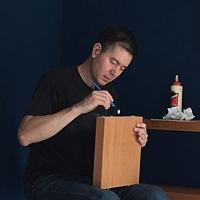Share your craft projects
Make new craft buddies
Ask craft questions
Blog your craft journey

Ron Stewart
861 posts
and
24 followers
in about 3 years
in about 3 years
More from Ron Stewart
Mobile Sewing Thread Storage Rack #3: Fabricating the Rack Frames
This is
part 3
in a
11 part
series:
Mobile Sewing Thread Storage Rack
-
Starting on the Spool Blocks
-
Fabricating the Rack Frames
-
Completing the Spool Blocks
...
- Starting on the Spool Blocks
- Fabricating the Rack Frames
- Completing the Spool Blocks
...

The rack sides are 1 3/8” wide, and I needed to drill vertically centered 1/4” diameter holes spaced 3” apart in their inner sides. I had two options: (1) use my drill press, incrementally moving the stop block exactly 3” as I moved from hole to hole, or (2) use my JessEm dowel jig which, as luck would have it, can space holes 3” apart.
Using the dowel jig seemed simpler, except for one thing. The jig’s fence moves in 1/8” increments, meaning I couldn’t set it to drill holes centered across the width. (When using the jig for dowel joinery, it doesn’t matter if the holes are perfectly centered.) To compensate for that, I cut a 1/16” thick strip of scrap and taped it to the fence as a spacer.
Using the dowel jig seemed simpler, except for one thing. The jig’s fence moves in 1/8” increments, meaning I couldn’t set it to drill holes centered across the width. (When using the jig for dowel joinery, it doesn’t matter if the holes are perfectly centered.) To compensate for that, I cut a 1/16” thick strip of scrap and taped it to the fence as a spacer.

Then it was a simple matter of placing the jig to offset the first hole the correct distance from the side’s bottom edge. I used my combination square to offset the jig. Then I drilled the first hole.

Unfortunately, the first hole I drilled was on the wrong side. It was a case where my brain asked, “Did you clamp the side to the bench inside up? Am I about to drill into the wrong side?” Then it shouted, “No you didn’t, and yes you are, you bleeping idiot! STOP!” My trigger finger got the message an instant too late, and I had a nice conical depression just where I didn’t want it. I swear, I sometimes wonder how I manage to dress myself in the morning. It wasn’t the end of the world, though. Maybe I could cover it with a butt hinge, or I’d have to patch it. I decided to worry about it later. I’m not including a photo here, but I’m sure you’ll see the mistake in some photos in subsequent posts.
I flipped the board around, repeated the process, and drilled the first hole in the correct location. After that, all I had to do was insert the jig’s indexing pin in the first hole and drill the next hole using the guide sleeve on the jig’s opposite edge. I repeated this procedure until I drilled the last hole.

In short order, all the holes were finished.

Now it was time to cut the notches for the tilt stops. At this point, my design called for 3/16” square tilt stops, like these. These stops would align with the tops of the spool blocks.

I was worried about two things. First, could I fabricate perfectly square stops that small? Second, even if I could, how was I going to cut the corresponding notches in the sides? I don’t have a 3/16” diameter router bit, and I don’t have a 3/16” wide saw blade. Before continuing, I decided to sleep on it and see if I could find a better solution.
After a day or two, I came up with scheme shown in the rendering at the top of this post. The tilt stops have a rectangular cross section (13/32” wide and 9/64” thick) and align with the bottoms of the spool blocks. The spool blocks now require a beveled notch on the bottom, and the top of the notched area rests on the stop. (The spool blocks were going to require more work, but the overall tradeoff seemed better to me.)
The 9/64” thickness happens to match the width of the saw kerf cut by my Freud FTG blade. That means that cutting the notches in the sides would be simple: just one pass over the blade set at 13/32” height per notch. The 13/32” is a result of SketchUp modeling. I (virtually) experimented with different widths for the stop and the block notches until I found something that would enable the blocks to rotate down 45 degrees.
With that settled, I started marking the notch locations. I put a dowel pin in each hole, dropped a spool block over it, and marked the bottom edge of the block, using a square for alignment.


Then I cut the notches using my crosscut sled. As with the pivot holes, I had to manually locate the position of the first notch in each pair of sides. I cut paired sides so that any error would be the same on both sides, meaning that the stops would be level even if they were slightly too high or low. Then I used a 3” long spacer block to move the sled’s stop block over for the next cut.

I checked the locations as I went along.

After I finished, I clamped each pair of matching sides together for a more comprehensive check. The results weren’t perfect, but they were pretty good. If memory serves, I left a bit of extra length on both ends of the sides so I could square them and cut them to their final size.

(It was at this point that I realized that I may have inadvertently spawned a race of wooden Cybermen. If you’re a Doctor Who fan, you may get the joke. If not, don’t bother. It’s not that funny anyway.)
If I had to build this project over, I’d find a better way to position the notches relative to the holes. I’d ditch the spacer block. Instead, I’d devise some sort of indexing jig (like a sacrificial fence for my sled with a little pin on it)—something like the table saw box joint sleds/jigs I’ve seen. I think that would produce more accurate results.
With the notches cut, it was time to move on to the actual tilt stops. I’ve never tried planing anything down to a hair over 1/8” thickness, but I thought I’d give it a try. To my great surprise, it worked. I think it helped that I had fairly long (40” or so) stock. I cut 13/32” wide strips from the planed stock and then crosscut the strips to length, leaving about an extra 1/16” on each end.


Now I was able to dry fit the four racks.


With that done, I was ready to return to the stop blocks.
4 Comments
All I can say is wow. Working with small parts is so difficult...and then so many!
Great call on using the doweling jig!
Small parts can be a pain, but you look to have it well sorted 👍
Small parts can be a pain, but you look to have it well sorted 👍
Nice write up! It looks like you came up with a good plan for the stops.
Looking good!
Ryan/// ~sigh~ I blew up another bowl. Moke told me "I made the inside bigger than the outside".












